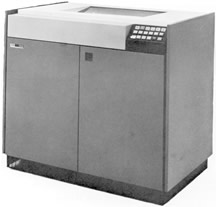
The 1132 line printer (pictured) was built to be inexpensive. Like Winmodems of a few years ago, its design reduced peripheral cost by increasing CPU involvement, and it was a dog: it ran at 80 lpm for alphanumeric text, with a CPU load near 100%. Its mechanism, taken from the obsolete IBM 407 punch-card accounting system, generated 88 interrupts per second while printing, with immediate attention required for each interrupt to avoid a printer fault. (The work required to service these interrupts was just too much for the least-expensive, slowest 1131. However, that CPU's low speed was artificial, implemented as a delay in the operation of a "normal" CPU to make a lower-cost system marketable, and as a workaround IBM's engineers simply disabled the CPU slowdown while a printer interrupt was pending. Clever users discovered this and found a way to speed up their programs: they started the 1132 and then, without clearing the printer interrupt, went about their CPU-intensive work at the higher speed. When their results were ready, they printed as usual.) The 1403 line printer, taken from the 1400 Computing System, was available for users who needed higher performance. Interfaced via an expensive channel-adapter interface nearly as large as the 1131, it could print at speeds up to 600 lpm and with dramatically lower CPU involvement: the channel adapter, using DMA, accepted data a line at a time and imposed no requirements for response times from the CPU. The 1403 was also used on the System/360, and continued in service at many locations into the 1980s and '90s. Built into the 1131 itself was the 1131 Console Printer, a very slightly modified 1050 I/O Selectric. (The modification is to include the 1131's bit switches into the 1050's front panel.) Like all Selectric products, the printer ran at 14.9 characters per second. Its type element could be changed, and in particular an APL typeball made the 1130 a nice, inexpensive interactive APL system. |